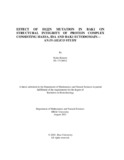| dc.contributor.advisor | Mubassir, M H M | |
| dc.contributor.author | Kinnori, Kuhu | |
| dc.date.accessioned | 2021-11-15T07:16:31Z | |
| dc.date.available | 2021-11-15T07:16:31Z | |
| dc.date.copyright | 2021 | |
| dc.date.issued | 2021-08 | |
| dc.identifier.other | ID 17136012 | |
| dc.identifier.uri | http://hdl.handle.net/10361/15615 | |
| dc.description | This thesis is submitted in partial fulfillment of the requirements for the degree of Bachelor of Science in Biotechnology 2021. | en_US |
| dc.description | Catalogued from PDF version of thesis. | |
| dc.description | Includes bibliographical references (pages 63-73). | |
| dc.description.abstract | Plants display immunity towards invading pathogens through layers of immunity. The pattern triggered immunity in Arabidopsis thaliana is the first layer of immunity against pathogens. Pattern Recognition Receptor Kinase, HAESA binds to Damage Associated Molecular Pattern, IDA, with the coreceptor SERK1. SERK1 is a member of the greater SERK family of receptor-like kinases. BAK1, alternatively known as SERK3, is also a representative of the SERK protein family. Therefore, it can be hypothesized that BAK1 could function alternatively to SERK1 protein in the HAESA-IDA complex. Besides, the elongated (elg) phenotype of BAK1 shows a mutation in the 122nd residue from Aspartate (Asp) to Asparagine (Asn). The viability of this mutated BAK1 as an alternative to SERK1 protein in the complex of HAESA LRR and IDA DAMP in terms of structural and residual alterations is checked in this research. The HAESA-IDA complex is docked and run through molecular dynamics simulation. The external molecular structure and internal residual arrangements are studied before and after the molecular dynamics simulation and checked for similarities and dissimilarities. Structural comparisons were made using HAESA-IDA-SERK1 (PDB ID: 5IYX) complex, and the FLS2-flg22-BAK1 complex (PDB ID: 4MN8) were used as references for the constructed experimental complex of HAESA-IDA-BAK1. Parameters like Root Mean Square Deviation (RMSD), Root Mean Square Fluctuations (RMSF), Hydrogen bonding, Solvent Accessible Surface Area (SASA), and Radius of Gyration (Rg) of the constructed tri-protein complex showed whether the complex is viable or not. High fluctuations in respective graphical data and incoherence of bond stability showed that mutated BAK1 in HAESA-IDA-BAK1 cannot form as a stable complex, hence the mutated BAK1 protein cannot be substituted for SERK1 in plant pattern triggered immunity. | en_US |
| dc.description.statementofresponsibility | Kuhu Kinnori | |
| dc.format.extent | 73 pages | |
| dc.language.iso | en | en_US |
| dc.publisher | Brac University | en_US |
| dc.rights | Brac University theses are protected by copyright. They may be viewed from this source for any purpose, but reproduction or distribution in any format is prohibited without written permission. | |
| dc.subject | HAESA | en_US |
| dc.subject | IDA | en_US |
| dc.subject | BAK1 | en_US |
| dc.subject | D122N mutation | en_US |
| dc.subject.lcsh | Plant diseases. | |
| dc.title | Effect of d122n mutation in bak1 on structural integrity of protein complex consisting Haesa, Ida and bak1 Ectodomain- an in-silico study | en_US |
| dc.type | Thesis | en_US |
| dc.contributor.department | Department of Mathematics and Natural Sciences, Brac University | |
| dc.description.degree | B. Biotechnology | |

